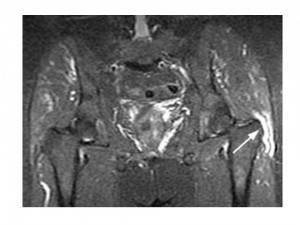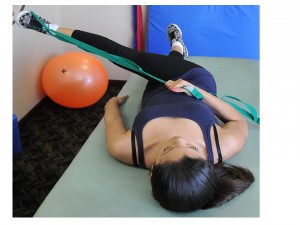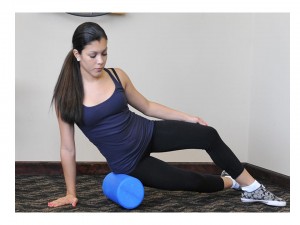News Letter, Vol. 3 (11), November, 2011, © Copyright
Jun Xu, M.D. Lic. Acup., Hong Su, C.M.D., Lic. Acup.
Robert Blizzard III, DPT
Rehabilitation Medicine and Acupuncture Center
1171 East Putnam Avenue, Building 1, 2nd Floor
Greenwich, CT 06878
Tel: (203) 637-7720
Hip Pain – Trochanteric Bursitis
http://jointsupplementreview.org/
Cindy is a 64 year-old female who complains of right hip pain for about six months after a fall in her garage and injury of her right hip. She felt immediate pain at right hip. Then, she put ice pack on the hip and took some Tylenol and Advil. She thought the pain would go away. However, after one month, the pain still was very severe and she had difficulty walking. She was unable to lie on the right side because of the pain, which always awakened her up during the night. Whenever she tried to walk, run, or lift some weight such as 10 to 20 pounds, her right hip was very painful with right leg weakness. The pain sometimes also radiated down to her knee but not below the knee. She then called her primary care physician, and an x-ray was done, which showed no bone spur, no fracture, and no osteoarthritis, and while the PCP examined her, her hip was swelling and slightly warm. The range of motion of her right hip was slightly limited. Her PCP told her it was soft tissue injury, it would get better in about one month. She was prescribed Naproxen. However, the pain is getting worse and worse. Now, she is limping and leaning to the right side. The pain interferes her daily activities such as driving, walking, lying on right side, etc. Therefore, she comes to me for evaluation and the treatment.
Physical Examination: Cindy is moderately obese and tall. She walks with a cane because the pain is so severe, she could not walk independently. I palpated her right hip joints which is swollen and very tender. The pain also goes along the right side lateral thigh. I checked her range of motion. At this time, the range of motion is slightly limited especially at the external rotation. I asked her to flex and external rotate her hip by pushing my hand resistant outward, she feels excruciated pain. Her right hip joint muscle seems weak. By sensation examination, her both legs are equal to the pinprick and light touch. There is no sensory deficit.
Because of the severe right hip pain and debilitating, I decided to order MRI. The MRI only showed the trochanteric bursa was swollen, tender, and increased in size. There is no any other tendonitis or arthritis.
This patient most likely has hip bursitis, i.e., trochanteric bursitis. On the hip, we have two trochanteric bursae, one is called superficial trochanteric bursa which is on top of the femoral head, i.e., outside the hip joint. The other one is called deep trochanteric bursa, a deep bursa, which is underneath the gluteus medius muscle. Hip bursitis are inflamed conditions of hip bursa. The patients with hip bursitis typically complain lot of hip pain, although the hip joint itself is not involved. The pain very often radiates down to the lateral aspect of the thigh.
Fig 11.1
www.skillbuilders.patientsites.com
Fig 11.2
STIR coronal image demonstrates increased signal lateral to the left greater trochanter (arrow).
www.radsource.us
The course and risk factors of hip bursitis: The hip bursitis usually is caused by contusions from falls, contact sports, and/or by the bursal irritation resulting from friction by the iliotibial pain (ITB).
this condition is most common in the middle aged or elderly, and especially prevalent among women with the following conditions:
- Repetitive activity such as stair climbing, bicycling, standing, running, hiking for long periods of time.
- An injury such as a fall, or lying on the side for long periods of time, exerting unnecessary pressure on the hip.
- Lower back pain, caused by arthritis, scoliosis, spondylosis, etc.
- Previous surgery, such as surgery around the hip or total hip replacement which can irritate the bursa and cause bursitis.
- Leg length discrepancy. This will change the center of gravity and cause irritation of the hip bursa.
for example, which is repetitive and cumulative irritation. Sometimes, leg length discrepancy and lateral hip surgery also can cause hip bursitis.
The symptoms of hip bursitis include:
- Hip pain. The pain sometimes radiates to the outside of the thigh to the knee area, as well as to the groin area. The pain may be worse during activities such as running or sitting with the leg crossed over the opposite knee.
- The pain may disturb sleep, especially when the patient is lying on her right side.
- Swelling may occur from the increased fluid within the bursa.
- The condition may cause limping and the patient may have difficulty walking or running.
- Heat and redness may occur on the affected bursa.
Hip bursitis usually is not related to osteoarthritis. Therefore, by the MRI or x-ray, you cannot see the hip spur, bone spur, or narrowing of the joint space. You may also not see the tendonitis around the hip joint and only see inflamed enlarged bursa. The differential diagnosis of hip bursitis is as following:
- Fracture of the femoral head
- Avascular necrosis of the femoral head
- hip fracture
- Lumbosacral radiculopathy
- Iliopsoas tendonitis
- ITB tendonitis
- Internal snapping hip and external snapping hip, etc.
Western Medicine Treatment:
- Most often, physician will prescribe anti-inflammatory medication such as naproxen, Advil, etc. Usually, there is no significant improvement after taking the naproxen, etc., because the bursitis is acute and severe inflammation on the bursa of the hip but many patients like to take anti-inflammatory medication.
- Rehabilitation program by physical therapy. Very often, physical therapy should be applied by stretching of the ITB, tensor fascia lata, external hip rotators, quadriceps, and hip flexors. The physical therapy modality such as cold pad, electrical stimulation, and soft tissue massage might be also helpful.
Fig 12.3
Fig 22.4
- Corticosteroid injection. There are many studies which showed the corticosteroid injection at the inflamed bursa can have quick, specific, and effective treatment with prolonged benefit. Usually, the patient should lie on the unaffected side. About 40 mg to 80 mg corticosteroid with 5 cc of 1% to 2% of lidocaine mixed to inject to the bursa about 66% of patients at a followup visit at one year and five years feel much improved.
As an acupuncturist, we should do as the following
- Have the patient to rest. Instructed the patient do not perform any repetitive activity for at least one month, and in the meantime, put ice massage on the hip about 15 minutes to 20 minutes twice a day on the hip and the ITB. Because the inflammation inside the hip bursa, the fluid very often leaks out followed the ITB and makes the ITB inflammation. That is why, the pain radiates down to the lateral thigh. Because of ITB is attached around the knee, the pain will not go down beyond the knee. Therefore, the massage with ice is a very important procedure to decrease the inflammation and pain.
- Acupuncture. The acupuncture usually I choose GB 30 Huan Tiao, Arshi GB31 Feng Shi, GB34 Yang Ling Quan, Sp9 Ying Ling Quan, Sp10 Xue Hai and Liv3 Tai Chong.
| Points | Meridan/No. | Location | Function/Indication | |
| 1 | Huan Tiao | GB 30 | At the junction of the lateral 1/3 between the great trochanter and the hiatus of the sacrum. | Pain of the lumbar region and the thigh, muscular atrophy of the lower limbs, hemiplegia |
| 2. | Feng Shi | GB 31 | On the midline fo the lateral aspect of the thigh, 7 inch above the transverse popliteal crease. | Pain and soreness in the thigh and lumbar region, paralysis of the lower limbs, beriberi, general pruritus |
| 3. | Yang Ling Quan | GB 34 | In the depression anterior and inferior to the head of the fibula | Hemiplegia, weakness, numbness and pain of the knee, beriberi, hypochondriac pain, bitter taste in the mouth, vomiting, jaundice, infantile, convulsion |
| 4. | Ying LingQuan | Sp 9 | On the lower border of the medial condyle of the tibia, in the depression on the medial border of the tibia | Abdominal pian and distension, diarrhea, dysentery, edema, jaundice, dysuria, enuresis, incontinence of urine, pain in the external genitalia, dysmenorrheal, pain in the knee |
| 5. | Xue Hai | Sp 10 | When the knee is flexed, 2 inch above the medial edge of patella. | Irregular menstruation, dysmenorrheal, uterine bleeding, amenorrhea, urticaria, eczema, erysipelas, pain in the medial aspect of the thigh |
| 6 | Tai Chong | Liv 3 | On the dorsum of the foot, in the depression distal to the junction of the first and second metatarsal bones. | Headache, dizziness and vertigo, insomnia, congestion, swelling and pain of the eye, depression,, infantile convulsion, deviation of the mouth, pain in the hypochondriac region, uterine bleeding, hernia, enuresis, retention of urine, epilepsy, pain the anterior aspect of the medial malleolus |
I choose the big diameter needle and with electrical stimulation at the bursa and the big needle usually can make the swelling going down and increase the energy flow go through the bursa. The stimulation can repetitively stimulate the bursa making the patient pain sensitivity going down and the patient will tolerate more the stimulation and the daily activity. Other points such as Hegu and Taichong will increase large dosage of endorphin secretion which will make the patient feel less pain.
Cindy underwent my treatment for about 10 visits and with soft massage, ice, and acupuncture with electrical stimulation and she feels much better after the treatment. She followed up once after two months and her hip pain is completely gone.
Tips for Acupuncturist:
- Always ask the patient to rest and ice massage, and if you understand some Chinese herb, you can choose some Chinese herb cream with anti-inflammation function to massage the patient’s hip and ITB.
- If the patient’s hip has obvious severe inflammation or infection, do not treat and you should refer the patients to her or his primary care physicians to check if there is any infection.
- A large diameter needle with electrical stimulation will be much more effective than the small diameter needle without electrical stimulation.
- You may teach the patient to stretch the right ITB band and hip joints in a certain way.
Tips for Patients:
- Not all the physicians can make a clear diagnosis about hip trochanteric bursitis. You have to consult physicians of orthopedics and physiatrists.
- Ice massage is very important treatment method, you must use ice to massage your hip 15 min 2x a day in order to reduce the inflammation and decrease pain.






